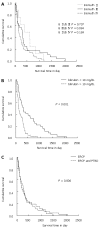Long-term outcome and prognostic factors of patients with hilar cholangiocarcinoma
- PMID: 17457974
- PMCID: PMC4146927
- DOI: 10.3748/wjg.v13.i9.1422
Long-term outcome and prognostic factors of patients with hilar cholangiocarcinoma
Abstract
Aim: To evaluate the long-term outcome and prognostic factors of patients with hilar cholangiocarinoma.
Methods: Ninety-six consecutive patients underwent treatment for malignant hilar bile duct tumors during 1995-2005. Of the 96 patients, 20 were initially treated with surgery (n = 2 R0 / n = 18 R1). In non-operated patients, data analysis was performed retrospectively.
Results: Among the 96 patients, 76 were treated with endoscopic transpapillary (ERC, n = 45) and/or percutaneous transhepatic biliary drainage (PTBD, n = 31). The mean survival time of these 76 patients undergoing palliative endoscopic and/or percutaneous drainage was 359 +/- 296 d. The mean survival time of patients with initial bilirubin levels > 10 mg/dL was significantly lower (P < 0.001) than patients with bilirubin levels < 10 mg/dL. The mean survival time of patients with Bismuth stage II (n = 8), III (n = 28) and IV (n = 40) was 496 +/- 300 d, 441 +/- 385 d and 274 +/- 218 d, respectively. Thus, patients with advanced Bismuth stage showed a reduced mean survival time, but the difference was not significant. The type of biliary drainage had no significant beneficial effect on the mean survival time (ERC vs PTBD, P = 0.806).
Conclusion: Initial bilirubin level is a significant prognostic factor for survival of patients. In contrast, age, tumor stage according to the Bismuth-Corlette classification, and types of intervention are not significant prognostic parameters for survival. Palliative treatment with endoscopic or percutaneous biliary drainage is still suboptimal, new diagnostic and therapeutic tools need to be evaluated.
Figures




Similar articles
-
Surgical procedure and prognosis of hilar cholangiocarcinoma.Hepatobiliary Pancreat Dis Int. 2004 Aug;3(3):453-7. Hepatobiliary Pancreat Dis Int. 2004. PMID: 15313688
-
[Effects of preoperative percutaneous transhepatic biliary drainage on surgical treatment of type Ⅲ and Ⅳ hilar cholangiocarcinoma].Zhonghua Wai Ke Za Zhi. 2019 Apr 1;57(4):288-292. doi: 10.3760/cma.j.issn.0529-5815.2019.04.009. Zhonghua Wai Ke Za Zhi. 2019. PMID: 30929375 Chinese.
-
Palliative treatment with self-expandable metallic stents in patients with advanced type III or IV hilar cholangiocarcinoma: a percutaneous versus endoscopic approach.Gastrointest Endosc. 2009 Jan;69(1):55-62. doi: 10.1016/j.gie.2008.04.005. Epub 2008 Jul 26. Gastrointest Endosc. 2009. PMID: 18657806
-
[Endoscopic staging of hilar cholangiocarcinoma].Korean J Gastroenterol. 2005 Jul;46(1):16-9. Korean J Gastroenterol. 2005. PMID: 16030399 Review. Korean.
-
[Cholangiocarcinoma].Rev Med Chil. 2008 Feb;136(2):240-8. Epub 2008 May 7. Rev Med Chil. 2008. PMID: 18483680 Review. Spanish.
Cited by
-
ERCC1 Can Be a Prognostic Factor in Hilar Cholangiocarcinoma and Extrahepatic Bile Duct Cancer, But Not in Intrahepatic Cholangiocarcinoma.Cancer Res Treat. 2013 Mar;45(1):63-9. doi: 10.4143/crt.2013.45.1.63. Epub 2013 Mar 31. Cancer Res Treat. 2013. PMID: 23613672 Free PMC article.
-
Serum albumin predicts survival in patients with hilar cholangiocarcinoma.Gastroenterol Rep (Oxf). 2017 Feb;5(1):62-66. doi: 10.1093/gastro/gow021. Epub 2016 Jul 6. Gastroenterol Rep (Oxf). 2017. PMID: 27389416 Free PMC article.
-
Development of a questionnaire (EORTC module) to measure quality of life in patients with cholangiocarcinoma and gallbladder cancer, the EORTC QLQ-BIL21.Br J Cancer. 2011 Feb 15;104(4):587-92. doi: 10.1038/sj.bjc.6606086. Epub 2011 Jan 25. Br J Cancer. 2011. PMID: 21266979 Free PMC article.
-
Primary patency of percutaneously inserted self-expanding metallic stents in patients with malignant biliary obstruction.HPB (Oxford). 2009 Jun;11(4):358-63. doi: 10.1111/j.1477-2574.2009.00069.x. HPB (Oxford). 2009. PMID: 19718365 Free PMC article.
-
Preoperative evaluation with T-staging system for hilar cholangiocarcinoma.World J Gastroenterol. 2007 Nov 21;13(43):5754-9. doi: 10.3748/wjg.v13.i43.5754. World J Gastroenterol. 2007. PMID: 17963304 Free PMC article. Clinical Trial.
References
-
- Bismuth H, Castaing D, Traynor O. Resection or palliation: priority of surgery in the treatment of hilar cancer. World J Surg. 1988;12:39–47. - PubMed
-
- de Groen PC, Gores GJ, LaRusso NF, Gunderson LL, Nagorney DM. Biliary tract cancers. N Engl J Med. 1999;341:1368–1378. - PubMed
-
- Ahrendt SA, Nakeeb A, Pitt HA. Cholangiocarcinoma. Clin Liver Dis. 2001;5:191–218. - PubMed
-
- Isa T, Kusano T, Shimoji H, Takeshima Y, Muto Y, Furukawa M. Predictive factors for long-term survival in patients with intrahepatic cholangiocarcinoma. Am J Surg. 2001;181:507–511. - PubMed
-
- Hanazaki K, Kajikawa S, Shimozawa N, Shimada K, Hiraguri M, Koide N, Adachi W, Amano J. Prognostic factors of intrahepatic cholangiocarcinoma after hepatic resection: univariate and multivariate analysis. Hepatogastroenterology. 2002;49:311–316. - PubMed
MeSH terms
Substances
LinkOut - more resources
Full Text Sources
Medical

